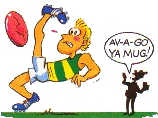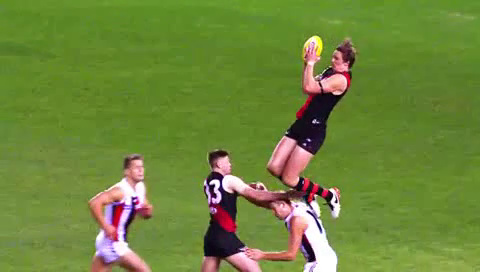glossary of terms
Australian Football has developed a unique and rich terminology.
This list is an alphabetical glossary of terms, jargon and slang.
H
- have a go
- to make a gutsy effort
- The great Aussie barracking cry.
Have a go!
- hey-diddle-diddle
- the middle
- He's dobbed it straight through the hey- diddle- diddle
-
rhyming slang: diddle for middle
- half-back flank
- a position on the half-back line
- The half-back line consists of three players, who are the first line of defence and key players in winning the ball, creating and assisting in attack.It was traditionally a defensive position, where reliability and toughness were more important than attacking flair.In the modern game, these attributes are combined with the ability to run and carry the ball as well as take on the opposition in a counter-attacking style.
- half-forward flank
- a position on the half-forward line
- Standing wide of the centre half-forward, this position provides an alternate target for balls coming from the midfield. They usually move the ball into the forward line by kicks or passes, or have a shot at goal themselves. These days they usually push into the midfield and, rather than being a specialist position it can be played by centres, wingers, rovers/ruck rovers, or even attacking half-back flankers.
The directly opposing player is a half-back. - hammy
- colloquialism for a hamstring injury
- He's pulled a hammy!
Straining of the hamstring, also known as a pulled hamstring, is defined as an excessive stretch or tear of muscle fibers and related tissues. - handball ∼ handpass
- the primary means of disposing of the football by hand
- Executed by holding the ball with either hand and punching it with the other.In order to be a legal disposal the player must hold the ball with one hand and punch the ball away with the clenched fist of the other hand.A player typically punches with his dominant hand; ie holding the ball with the left hand and punching with the right is considered a right-handed handball.
- handy point
- colloquial term for a behind scored near the end of a close game
- A point which increases a teams score to one more than a multiple of six.For example, from six to seven points, from twelve to thirteen points, or from eighteen to nineteen points).So called because it means the opposition needs an extra scoring shot to tie or win the game.
- hanger ∼ speckie, screamer
- a spectacular overhead mark
- Where the player seems to hang in the air.
 Refers to the act of leaping onto the back or shoulders of another player known as the stepladder in order to take a high mark, usually in a contested situation.Commentators will often call an individual mark a contender in reference to the AFL's annual Mark of the Year and it's likelihood to win.
Refers to the act of leaping onto the back or shoulders of another player known as the stepladder in order to take a high mark, usually in a contested situation.Commentators will often call an individual mark a contender in reference to the AFL's annual Mark of the Year and it's likelihood to win. - hard ball get
- a possession achieved as a result of winning a contest
- hip-and-shoulder
- the act of using the side of the body and running into an opponent with force
- One of a variety of actions which benefit the team.
See one percenter for more information. - hit the woodwork
- a kicked ball that touches a goal or behind post
- Thus scoring a behind. Also known as a poster.
- hitout
- knocking the ball out of the ruck contest
- Regardless of which side wins the following contest at ground level.
- high flyer
- an adept at taking high marks
- hoofa
- the game of aussie rules footy
wa slang
- holding the ball
- an infringement of the rules
- The rule results in a free kick being awarded against a player if he fails to correctly dispose of the football upon being tackled by an opponent, although not under all circumstances. The rule provides the defending team a means to dispossess a player who is running with the football, as well as preventing players from slowing the play. The holding the ball rule dates to the formative years of the game. It has a long history as one of the most contentious rules in the game and one of the most difficult to umpire consistently, in large part due to the several points of umpire discretion involved in its interpretation. Specific variations of the rule apply depending upon how the player came to be in possession of the ball.
The Laws of the Game, 2021 18.6.1 Spirit and Intention.
The Player who has Possession of the Football will be provided an opportunity to dispose of the football before rewarding an opponent for a Legal Tackle.18.6.2 Prior Opportunity.
Where a Player in Possession of the Football has had Prior Opportunity, a field Umpire shall award a Free Kick if that Player does not Correctly Dispose of the football immediately when they are Legally Tackled.18.6.3 Incorrect Disposal.
Where a Player in Possession of the Football has not had Prior Opportunity, a field Umpire shall award a Free Kick if that Player elects to Incorrectly Dispose of the football when Legally Tackled.For the avoidance of doubt, a Player does not elect to Incorrectly Dispose of the football when:
- (a) the Player genuinely attempts to Correctly Dispose of the football;
- (b) the Legal Tackle causes the football to be dislodged from the Player’s possession.
18.6.4 No Genuine Attempt.
Where a Player in Possession of the Football has not had Prior Opportunity, a field Umpire shall award a Free Kick if the Player is able to, but does not make a genuine attempt to Correctly Dispose of the football within a reasonable time when Legally Tackled.18.6.5 Diving on Top of the Football.
A field Umpire shall award a Free Kick against a Player who dives on top of or drags the football underneath their body and fails to immediately knock clear or Correctly Dispose of the football when Legally Tackled. - holding the man
- an infringement of the rules
- This occurs when a player is tackling his opponent without the ball. If the team whose player committed the infringement plays on, then a free kick will be awarded.
However, if the team whose player was tackled without the ball plays on, then the advantage is paid. - hospital kick
- a very high kick to a teammate
- Which allows opposition players to run in and crash into the person attempting to mark the kick. Can also be a hospital pass.
- huddle
- 1 the grouping of players around the captain
- After the coin toss, and following quarter‑time and three‑quarter‑time breaks.
- 2 a tactic after a behind is scored
- All players in the backline gather together about fifty meters from goal. Then the players individually lead away in all directions. The technique means that there will be several leading players, making it difficult to defend the first kick‑in. It also allows teams to run set plays for the second and third kicks. Developed during the 1970s and is still used today by many teams.
Australian Football has developed a unique and rich terminology.
This list is an alphabetical glossary of terms, jargon and slang.





















